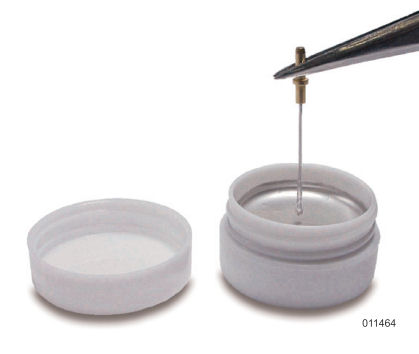Ag/AgCl Ink for Reference electrode (cat#011464)

Reference electrodes can be easily prepared by coating Ag/AgCl ink on the metal (Ag, Pt, Au, etc.) surface. The only thing you are required to do is just to deposit the Ag/AgCl ink and wait for dry. The reference electrode prepared by Ag/AgCl ink is quite useful for IDA electrode, micro CV cell measurements and so on.
Only paint and dry
Silver/Silver chloride reference electrode has a long long life time resulting in one of the most stable ans reproducible reference electrode. Conventionally, in order to manufacture the own silver/silver chloride reference electrode, the silver wire or plate is prepared by silver chloride electrolysis coating over a constant potential, for which the technical knowledge is required. In addition, if the material of the electrode is gold or platinum, before the process above the metal surface required to be silver plated.
ALS has a wide line up of the silver/silver chloride reference electrode, such as RE-1B Reference electrode (Ag/AgCl) and RE-1CP Reference electrode (Ag/AgCl/Saturated KCl), also using the Ag/AgCl Ink painting in any metal, the silver/silver chloride functional reference electrode will be possible.
For use, only paint and dry. It is ready for use, after dry for half day to one day, to avoid the dust stick. If the material used has not a low melting point, such as plastic or rubber material, drying at 120 degrees for about 5 minutes in a oven, it will be more quickly and strongly fixed.
∗For the coating of the reference electrode, which is a tight side, use a soft palette as a thin head of the toothpick.
| Catalog No. | Description |
| 011464 | Ag/AgCl Ink for Reference electrode 2.0 mL |
| Specification | |
| Surface resistance | 0.2 Ω/sq/25.4 µm |
| Viscosity | 50,000 ± 10,000 CP @21.1 °C |



